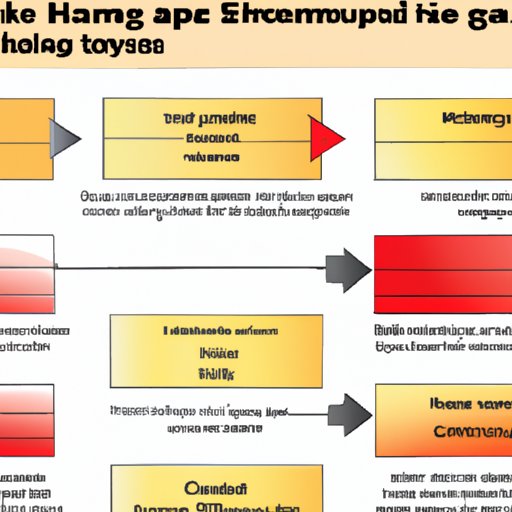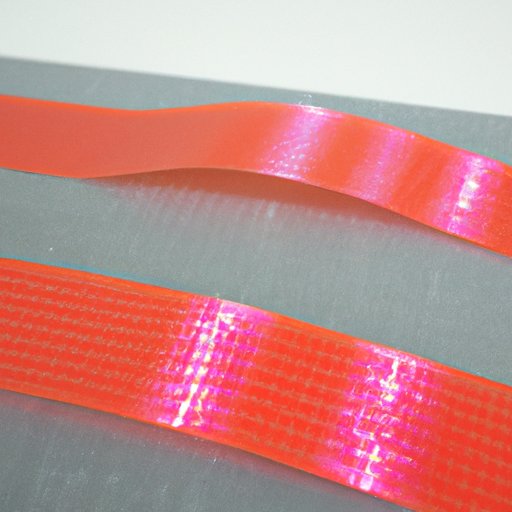Introduction
Heat tape is an essential tool for keeping pipes and other surfaces warm during cold weather. It works by providing a steady source of heat that prevents the formation of ice or frost. It has many different uses and can be used to protect pipes, roofs, gutters, and more. In this article, we’ll explore how heat tape works and provide a comprehensive guide to understanding its functionality.
Exploring the Science Behind Heat Tape: How Does It Work?
Heat tape is a type of electric cable that produces heat when electricity passes through it. The heat is then transferred to whatever surface the heat tape is applied to. It’s important to note that heat tape is not the same as electrical tape, which is designed to insulate electrical wires from each other. Heat tape is specifically designed to produce heat.
Heat tape works by converting electrical energy into thermal energy. When electricity passes through the heat tape, it causes resistance, which generates heat. This heat is then transferred to the surface that the heat tape is applied to. Heat tape is typically made from copper or aluminum and comes in various lengths and wattages. The wattage of the heat tape determines how much heat it produces.
Heat tape has many benefits. It’s easy to install and can be used in both indoor and outdoor applications. It’s also more cost-effective than traditional heating systems. Additionally, it’s safer than other heating solutions because it produces less heat and doesn’t require combustible fuels. Finally, heat tape is relatively low maintenance and doesn’t require any special cleaning or maintenance.

Heat Tape Basics: A Guide to Understanding its Functionality
When choosing heat tape, there are several factors to consider. First, you need to determine the wattage of the heat tape. This will determine how much heat it produces and how long it will stay on. You also need to consider the length of the heat tape and where it will be installed. Additionally, you need to think about the type of heat tape you need. There are two main types of heat tape: self-regulating and constant wattage.
Self-regulating heat tape automatically adjusts its wattage depending on the temperature of the surface it’s applied to. This type of heat tape is ideal for applications that require precise control over the amount of heat produced. Constant wattage heat tape, on the other hand, produces a steady stream of heat regardless of the temperature of the surface it’s applied to. This type of heat tape is ideal for applications that require consistent heat production.
Once you’ve chosen the right heat tape for your application, you need to properly install it. Heat tape should always be installed according to the manufacturer’s instructions. It should also be installed away from any flammable materials and in areas that are well-ventilated. Additionally, heat tape should be inspected regularly to ensure it’s working properly.
Putting the Heat on: An In-Depth Look at Heat Tape Technology
Heat tape consists of three main components: a conductor, an insulation layer, and a protective outer layer. The conductor is typically made of copper or aluminum and is responsible for conducting electricity. The insulation layer helps prevent heat loss and ensures that the heat is distributed evenly. Finally, the protective outer layer helps protect the heat tape from damage.
Heat tape can distribute heat in a variety of ways. Depending on the design of the heat tape, it can either distribute heat directly or indirectly. Direct heat distribution occurs when the heat tape is wrapped around a surface and the heat is transferred directly to the surface. Indirect heat distribution occurs when the heat tape is placed inside a tube and the heat is transferred to the air inside the tube.
When working with heat tape, it’s important to follow safety precautions. Heat tape should never be installed near flammable materials or in damp locations. Additionally, heat tape should never be spliced or cut. If the heat tape needs to be replaced, it should be done by a qualified professional.
Keeping Warm with Heat Tape: How Does it Work?
Heat tape has many advantages. It’s an efficient way to keep surfaces warm without the use of traditional heating systems. Additionally, it’s easy to install and requires minimal maintenance. Heat tape can also be used in a variety of applications, including roof and gutter de-icing, pipe insulation, and even animal bedding.
When selecting heat tape for a specific application, there are several factors to consider. The wattage of the heat tape should match the size and shape of the area you’re trying to heat. Additionally, the length of the heat tape should be sufficient to cover the area you’re trying to heat. Finally, you should choose a heat tape that is rated for outdoor use if you plan to use it outdoors.
Heat tape requires minimal maintenance, but it should be inspected regularly to ensure it’s working properly. Additionally, the heat tape should be replaced periodically to ensure it’s functioning optimally. Finally, the heat tape should be disconnected from the power source during periods of non-use.
Practical Tips for Using Heat Tape: A Beginner’s Guide
Installing heat tape correctly is essential for ensuring it works properly. When installing heat tape, you should always follow the manufacturer’s instructions. Additionally, you should use a voltage tester to make sure the heat tape is connected to the correct power source. It’s also important to make sure the heat tape is securely fastened to the surface you’re trying to heat.
If you’re having issues with your heat tape, there are several troubleshooting steps you can take. First, check the power source to make sure it’s connected correctly. Additionally, make sure the heat tape is securely fastened to the surface and that it’s not damaged or frayed. Finally, check the wattage of the heat tape to make sure it’s adequate for the application.
If the heat tape needs to be replaced, it should be done by a qualified professional. Additionally, the new heat tape should be of the same type and wattage as the original. Finally, the new heat tape should be connected to the same power source as the old one.
What You Need to Know about Heat Tape and Its Uses
Heat tape is an affordable and effective way to keep surfaces warm during cold weather. The cost of heat tape varies depending on the type and wattage, but it’s usually relatively inexpensive. Heat tape is widely available in hardware stores, home improvement stores, and online retailers. Investing in heat tape is a wise decision, as it can save you money on energy bills and help prevent costly repairs due to frozen pipes.

How Heat Tape Works: A Comprehensive Overview
Heat tape is a great way to keep surfaces warm without the use of traditional heating systems. It works by converting electrical energy into thermal energy, which is then transferred to the surface it’s applied to. Heat tape is easy to install and requires minimal maintenance. It’s also relatively inexpensive and can be used in a variety of applications, from roof and gutter de-icing to pipe insulation.
When using heat tape, it’s important to follow safety guidelines and properly install it according to the manufacturer’s instructions. Additionally, it’s important to inspect the heat tape regularly and replace it when necessary. Finally, it’s important to select the right type and wattage of heat tape for the application.
Conclusion
Heat tape is an essential tool for keeping surfaces warm during cold weather. It works by converting electrical energy into thermal energy and transferring it to the surface it’s applied to. Heat tape is easy to install and requires minimal maintenance. It’s also relatively inexpensive and can be used in a variety of applications. By understanding how heat tape works and following safety guidelines, you can get the most out of this useful tool.
(Note: Is this article not meeting your expectations? Do you have knowledge or insights to share? Unlock new opportunities and expand your reach by joining our authors team. Click Registration to join us and share your expertise with our readers.)
